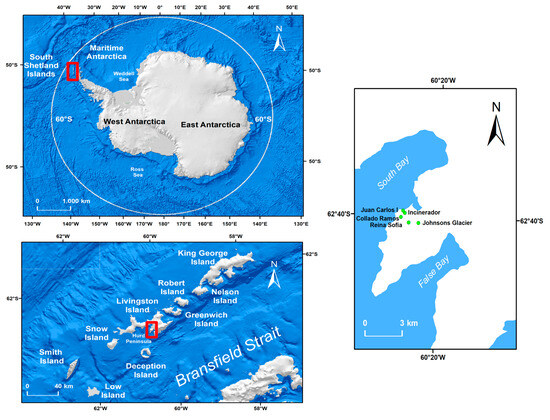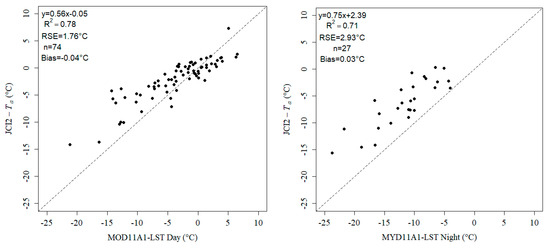Abstract
It is known that changes in temperature could cause changes in the Antarctic Ice Sheet, which would have an immediate and long-term impact on the global mean sea level. For this reason, the monitoring of air temperature (Ta) is of great interest to the scientific community. On the other hand, Antarctica constitutes an area of difficult access, which makes it difficult to obtain in situ data. Because of this, Land Surface Temperature (LST) remote sensing data have become an important alternative for estimating Ta. In this work, we estimated Ta from daytime and nighttime LST data at maritime Antarctic sites in the South Shetland Archipelago using empirical models, based on the addition of spatiotemporal variables. We used Ta data from the Spanish Antarctic stations and from the PERMASNOW project stations. MOD11A1 and MYD11A1 (Collection 6) Moderate Resolution Imaging Spectroradiometer (MODIS) LST products were downloaded from the Google Earth Engine platform and only the highest quality data were selected. Outliers associated with clouds were removed with filters. Two different multilinear regression models were tested: models for each individual station and global models based on the data from all the stations. The simple regression analysis LST against Ta showed that a better fit is always achieved with daytime LST data (R2 average = 0.73) than with nighttime LST data (R2 average = 0.56). The performance of the models was improved with the addition of spatiotemporal variables as predictive variables, with which we obtained an average R2 = 0.75 for daytime data and an average R2 = 0.60 for nighttime data. The global models allowed for improving the correlation and reducing the errors with respect to the models obtained using individual stations. Global models provide a precise description of the behavior of the temperature in maritime Antarctica, where it is not possible to install and maintain a dense network of weather stations.
1. Introduction
Air temperature (Ta) monitoring is of great interest to the scientific community. This is particularly important in polar areas, since it is known that Ta can influence the behavior of the active layer of permafrost [1], and that important changes in temperature could lead to changes in the accumulation of snow on the Antarctic ice sheet, which would have both an immediate impact and a long-term impact on the global mean sea level [2].
In polar areas, in addition, it is essential to use remote sensing data to monitor meteorological variables, given the scarcity of in situ data and the impossibility of maintaining a wide network of meteorological stations; therefore, the Land Surface Temperature (LST) is used as a proxy for Ta. Specifically on Livingston Island, Recondo et al. [3] obtained models for estimating Ta using Moderate Resolution Imaging Spectroradiometer (MODIS) LST collection 5 (C5). On the other hand, it is known that in collection 6 (C6), numerous improvements were made in the Generalized Split-Window (GSW) algorithm [4]. This makes it necessary to update the studies with MODIS LST (C6) data. For that reason, in this work, we estimate Ta from daytime and nighttime LST data at maritime Antarctic sites in the South Shetland Islands (SSI) archipelago using empirical models, based on LST with the addition of spatiotemporal variables [3].
2. Materials and Methods
2.1. Study Area
This work focuses on Livingston Island, in the SSI archipelago (Figure 1), which occupies an area of 3687 km2 and is located in the Maritime Antarctic. The Juan Carlos I (JCI) Spanish Antarctic base is located on this island.

Figure 1.
Study area. Left top image: map of Antarctica; in red rectangle, South Shetland Islands (SSI) archipelago. Left bottom image: Livingston Island; in red rectangle, Hurd Peninsula, where the stations used in this work are located. Right image: location of the stations.
2.2. In Situ Data
Ta data were taken from the stations of the State Meteorological Agency (AEMET) and from the PERMASNOW project [5,6], the locations of which are shown in Figure 1. Temporal range includes the years between 2000 and 2020. Mean daily air temperature was calculated and data from all stations were calibrated as indicated in Recondo et al. [3].
2.3. MODIS LST Data
MOD11A1 and MYD11A1 (C6) data were downloaded from the Google Earth Engine platform [7] and only the highest-quality data were selected. On the other hand, considering that the MODIS cloud mask sometimes fails [8,9], LST data were filtered using MOD10A1 and MYD10A1 products, respectively, and those corresponding to “clouds” were eliminated.
3. Results and Discussion
Previous studies have shown that MODIS LST products can be used to estimate Ta in Antarctica [10]. Firstly, we tried simple linear regression models for each station separately. The best fits were achieved with daytime data (average R2 = 0.73) than with nighttime data (average R2 = 0.56). As an example, in Figure 2, we show the best results obtained with daytime and nighttime data, both of them using Ta from JCI station (see Figure 1).

Figure 2.
Linear correlation between JCI mean daily air temperature, and MOD11A1 daytime LST (on the left) and MYD11A1 nighttime LST (on the right).
These values of R2 are in the range of the results obtained in the analysis of the correlation between Ta and LST, in other study areas [11,12]. Likewise, although the average R2 values of the diurnal data from Terra and Aqua are similar (0.73 and 0.72, respectively), the data from Terra show lower RSE values than those from Aqua. On the other hand, these results are much better than those obtained with the C5 data (R2 ≤ 0.4).
The performance of the model is improved with the use of a Fourier harmonic decomposition model [3]. For all the stations, R2 values are higher compared to the simple linear regression model and better results were obtained with daytime data (R2 in the range from 0.65 to 0.81) than with nighttime data (R2 in the range from 0.53 to 0.75), confirming previous results obtained using C5 [3].
Finally, we built a unique model by adding spatiotemporal variables and using the Ta from all the stations (see Table 1). In general, this model improved the correlation and reduced the errors. However, although the application of the unique model has not achieved the same level of accuracy for the estimation of Ta in all cases, it is a useful tool for extending the analysis to areas where it is not possible to obtain in situ data.

Table 1.
Unique model to estimate Air temperature (Ta) from Land Surface Temperature (LST) and spatiotemporal variables. The structure of the models is 1 .
All results, both from each station and the unique model, were validated using the leave-one-station-out cross-validation method and R2CV and RMSECV statistics. Generally, as expected, in validation, the regression values are lower and the errors are higher. As in the model, the best results are obtained with the Terra-Day data (R2 = 0.75, RMSE = 2.19).
4. Conclusions
In this work, we estimate Ta from daytime and nighttime LST data at sites in the SSI archipelago, in Maritime Antarctica, using empirical models. The results of simple linear regression models of LST vs. in situ Ta are consistent with those obtained in other study areas and also with other satellites and/or sensors, and they constitute evidence of the good agreement between Ta and LST.
A unique model including spatiotemporal variables allows the estimation of Ta from LST over areas where in situ Ta is not available.
Author Contributions
A.C.-P. and C.R. designed the study. A.C.-P. wrote the paper and analyzed data. C.R. and J.F.C. contributed to the critical analysis of the paper. All authors contributed to proofreading and commenting on the manuscript. All authors have read and agreed to the published version of the manuscript.
Funding
PERMASNOW project station data were obtained thanks to the Spanish Ministry of Economy and Competitiveness (MINECO) [CTM2014-52021-R]. A.C.-P. acknowledges the following Ph.D. grants: “Severo Ochoa” from the Government of the Principality of Asturias [BP17-151] and the “Predoctoral Grant” from the University of Oviedo. Javier F. Calleja acknowledges funding from the Spanish Ministry of Science and Innovation (project PID2021-127060OB-I00).
Institutional Review Board Statement
Not applicable.
Informed Consent Statement
Not applicable.
Data Availability Statement
MODIS data are available in the Google Earth Engine platform (http://earthengine.google.org, accessed on 15 August 2023).
Conflicts of Interest
The authors declare no conflicts of interest.
References
- Hrbáček, F.; Láska, K.; Engel, Z. Effect of Snow Cover on the Active-Layer Thermal Regime. A Case Study from James Ross Island, Antarctic Peninsula. Permafr. Periglac. Process. 2016, 315, 307–315. [Google Scholar] [CrossRef]
- Medley, B.; Thomas, E.R. Increased snowfall over the Antarctic Ice Sheet mitigated twentieth-century sea-level rise. Nat. Clim. Chang. 2019, 9, 34–39. [Google Scholar] [CrossRef]
- Recondo, C.; Corbea-Pérez, A.; Peón, J.; Pendás, E.; Ramos, M.; Calleja, J.F.; de Pablo, M.Á.; Fernández, S.; Corrales, J.A. Empirical Models for Estimating Air Temperature Using MODIS Land Surface Temperature (and Spatiotemporal Variables) in the Hurd Peninsula of Livingston Island, Antarctica, between 2000 and 2016. Remote Sens. 2022, 14, 3206. [Google Scholar] [CrossRef]
- Wan, Z. New refinements and validation of the collection-6 MODIS land-surface temperature/emissivity product. Remote Sens. Environ. 2014, 140, 36–45. [Google Scholar] [CrossRef]
- De Pablo, M.A.; Jiménez, J.J.; Ramos, M.; Prieto, M.; Molina, A.; Vieira, G.; Hidalgo, M.A.; Fernández, S.; Recondo, C.; Calleja, J.F.; et al. Frozen Ground and Snow Cover Monitoring in Livingston and Deception Islands, Antarctica: Preliminary Results of the—PERMASNOW Project. Cuad. Investig. Geogr. 2020, 46, 187–222. [Google Scholar] [CrossRef]
- De Pablo, M.A.; Ramos, M.; Molina, A.; Vieira, G.; Hidalgo, M.A.; Prieto, M.; Jiménez, J.J.; Fernández, S.; Recondo, C.; Calleja, J.F.; et al. Frozen ground and snow cover monitoring in the South Shetland Islands, Antarctica: Instrumentation, effects on ground thermal behaviour and future research. Cuad. Investig. Geogr. 2016, 42, 475–495. [Google Scholar] [CrossRef]
- Gorelick, N.; Hancher, M.; Dixon, M.; Ilyushchenko, S.; Thau, D.; Moore, R. Google Earth Engine: Planetary-scale geospatial analysis for everyone. Remote Sens. Environ. 2017, 202, 18–27. [Google Scholar] [CrossRef]
- Calleja, J.F.; Corbea-Pérez, A.; Fernández, S.; Recondo, C.; Peón, J.; de Pablo, M.Á. Snow Albedo Seasonality and Trend from MODIS Sensor and Ground Data at Johnsons Glacier, Livingston Island, Maritime Antarctica. Sensors 2019, 19, 3569. [Google Scholar] [CrossRef] [PubMed]
- Corbea-Pérez, A.; Calleja, J.F.; Recondo, C.; Fernández, S. Evaluation of the MODIS (C6) Daily Albedo Products for Livingston Island, Antarctic. Remote Sens. 2021, 13, 2357. [Google Scholar] [CrossRef]
- Wang, Y.; Wang, M.; Zhao, J. A Comparison of MODIS LST Retrievals with in Situ Observations from AWS over the Lambert Glacier Basin, East Antarctica. Int. J. Geosci. 2013, 4, 611–617. [Google Scholar] [CrossRef]
- Shi, S.; Helman, D.; Lensky, I.M. Worldwide continuous gap-filled MODIS land surface temperature dataset. Sci. Data 2021, 8, 74. [Google Scholar] [CrossRef]
- Yang, Y.Z.; Cai, W.H.; Yang, J. Evaluation of MODIS Land Surface Temperature Data to Estimate Near-Surface Air Temperature in. Remote Sens. 2017, 9, 410. [Google Scholar] [CrossRef]
Disclaimer/Publisher’s Note: The statements, opinions and data contained in all publications are solely those of the individual author(s) and contributor(s) and not of MDPI and/or the editor(s). MDPI and/or the editor(s) disclaim responsibility for any injury to people or property resulting from any ideas, methods, instructions or products referred to in the content. |
© 2023 by the authors. Licensee MDPI, Basel, Switzerland. This article is an open access article distributed under the terms and conditions of the Creative Commons Attribution (CC BY) license (https://creativecommons.org/licenses/by/4.0/).